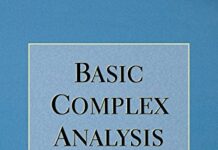
Ebook Info
- Published: 1999
- Number of pages: 604 pages
- Format: PDF
- File Size: 2.94 MB
- Authors: Jerrold E. Marsden
Description
A development of the basic theory and applications of mechanics with an emphasis on the role of symmetry. The book includes numerous specific applications, making it beneficial to physicists and engineers. Specific examples and applications show how the theory works, backed by up-to-date techniques, all of which make the text accessible to a wide variety of readers, especially senior undergraduates and graduates in mathematics, physics and engineering. This second edition has been rewritten and updated for clarity throughout, with a major revamping and expansion of the exercises. Internet supplements containing additional material are also available.
User’s Reviews
Editorial Reviews: Review “The book is self-contained.It remains a good and solid introduction to this subject.”Nieuw Archief voor Wiskunde, March 2001 “… This book takes the reader on one of the greatest journeys in modern mathematics that has as its roots a subject that is more than 300 years old. Armed with this knowledge a reader is ready to pursue numerous topics of active mathematical research, from the more pure domains of symplectic geometry and topology to the geometric analysis of the limitless supply of examples from mechanics.”Newsletter of the Newzealand Mathematical Society, No. 81, April 2001Second EditionJ.E. Marsden and T.S. RatiuIntroduction to Mechanics and SymmetryA Basic Exposition of Classical Mechanical Systems”As the name of the book implies, a consistent theme running through the book is that of symmetry. Indeed the latter half of the book focuses on Poisson manifolds, momentum maps, Lie-Poisson reduction, co-adjoint orbits and the integrability of the rigid body. The discussion of reduction must be the most comprehensive yet given. A pleasant feature of the book is that most of the theory that relates to finite-dimensional mechanical systems is illustrated concretely in terms of local coordinates, thereby making the book accessible even to beginners in the field.”―MATHEMATICAL REVIEWS
Reviews from Amazon users which were colected at the time this book was published on the website:
⭐Pulls together advanced mechanics concepts including Lie-Poisson brackets, momentum maps, and Dirac constraint theory. Helpful if already familiar with mechanics at the Goldstein or Landau/Lifshitz level. Excellent preparation for relativistic energy-momentum map literature (not covered in book.)
⭐This review is for Engineers. The back cover of the book says that it is accessible to advanced undergrads… to engineers etc. I am doing PhD in engineering and I have taken many classes in Math (including differential geometry, topology, analysis, PDEs, abstract algebra) and Mechanics. With great difficultyI read this book (about 50% of the book). It is not well-organized.The theory is not carefully developed. For example, the firstchapter is one of the difficult chapters to understand all thethings as it tries to give the summary of the book. The Chapter9 (on Lie groups) says that the definition on Lie Algebra isin the Introduction (it is not clear whether it is in the Introduction of the chapter or in the Introduction of thebook). After seeing in the index, one can find that it is in the Introduction of the text. If a person is encountering thiskind of stuff for the first time, how will he remember what is given in the Chapter 1 (given the fact that Chapter 1 is theone of the difficult chapters to read in this book). Do n’t you think it is logical to give this important definition in Chapter 9 as the previous chapters does not require this definition.The book may be suited for a class as the professor will guidethe students. But for self-study, I do not recommend this book.Instead I recommend the book by Arnold. Though the book byArnold is not as sophisticated as Marsden, it gives nicepicture for an engineer.
⭐As mathematically sophisticated as Arnold but, unlike Arnold, Marsden has the good grace to properly define fundamentals such as the various spaces and transformations used. The introductory exposition of similarities and differences of Lagrangian and Hamiltonian mechanics is most helpful and refreshing.
⭐
⭐
Keywords
Free Download Introduction to Mechanics and Symmetry: A Basic Exposition of Classical Mechanical Systems (Texts in Applied Mathematics, 17) 2nd Edition in PDF format
Introduction to Mechanics and Symmetry: A Basic Exposition of Classical Mechanical Systems (Texts in Applied Mathematics, 17) 2nd Edition PDF Free Download
Download Introduction to Mechanics and Symmetry: A Basic Exposition of Classical Mechanical Systems (Texts in Applied Mathematics, 17) 2nd Edition 1999 PDF Free
Introduction to Mechanics and Symmetry: A Basic Exposition of Classical Mechanical Systems (Texts in Applied Mathematics, 17) 2nd Edition 1999 PDF Free Download
Download Introduction to Mechanics and Symmetry: A Basic Exposition of Classical Mechanical Systems (Texts in Applied Mathematics, 17) 2nd Edition PDF
Free Download Ebook Introduction to Mechanics and Symmetry: A Basic Exposition of Classical Mechanical Systems (Texts in Applied Mathematics, 17) 2nd Edition




